BHS201A General Pathology: Case Study Report on Appendicitis
VerifiedAdded on 2022/11/28
|12
|2635
|253
Report
AI Summary
This report presents a comprehensive analysis of a pathology case study focusing on perforated appendicitis. It begins by establishing the context of the case, which involves a 28-year-old male presenting with right flank pain, fever, and other symptoms indicative of appendicitis. The core of the report examines the disease pathogenesis, detailing the infection process, the acute inflammatory response, wound healing, and the potential for chronic inflammatory responses. The discussion includes an overview of appendicitis epidemiology, the immune role of the appendix, and the specific mechanisms of infectious disease pathogenesis related to the condition. It also explores the cellular and tissue-level responses to injury, including the role of leukocytes, macrophages, and various mediators, as well as the phases of wound healing. Furthermore, the report considers the potential for chronic inflammatory responses in perforated appendicitis, considering surgical interventions and patient care. The conclusion summarizes the key findings, emphasizing the interconnectedness of the infection process, acute inflammation, and wound healing in the context of appendicitis.
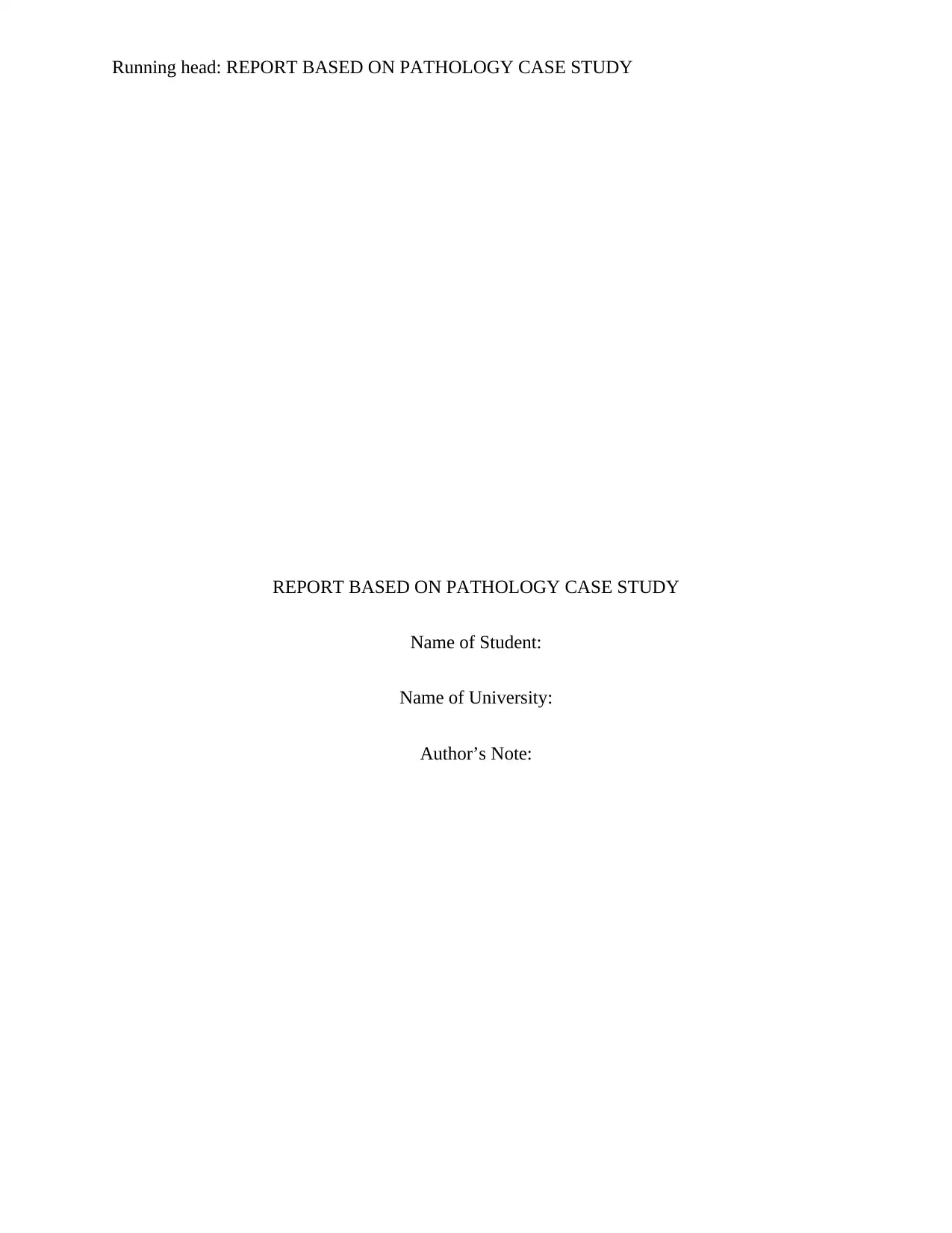
Running head: REPORT BASED ON PATHOLOGY CASE STUDY
REPORT BASED ON PATHOLOGY CASE STUDY
Name of Student:
Name of University:
Author’s Note:
REPORT BASED ON PATHOLOGY CASE STUDY
Name of Student:
Name of University:
Author’s Note:
Paraphrase This Document
Need a fresh take? Get an instant paraphrase of this document with our AI Paraphraser
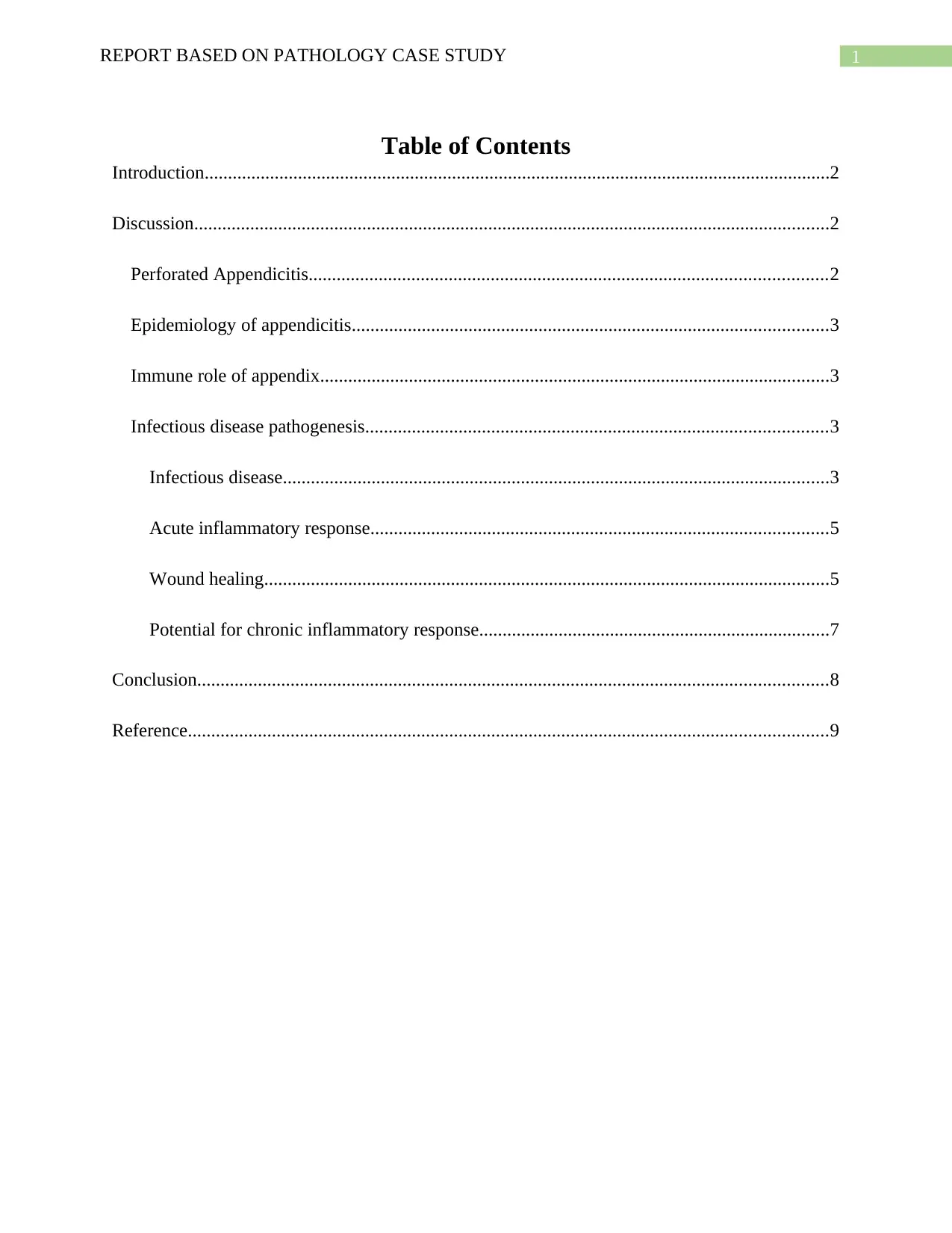
1REPORT BASED ON PATHOLOGY CASE STUDY
Table of Contents
Introduction......................................................................................................................................2
Discussion........................................................................................................................................2
Perforated Appendicitis...............................................................................................................2
Epidemiology of appendicitis......................................................................................................3
Immune role of appendix.............................................................................................................3
Infectious disease pathogenesis...................................................................................................3
Infectious disease.....................................................................................................................3
Acute inflammatory response..................................................................................................5
Wound healing.........................................................................................................................5
Potential for chronic inflammatory response...........................................................................7
Conclusion.......................................................................................................................................8
Reference.........................................................................................................................................9
Table of Contents
Introduction......................................................................................................................................2
Discussion........................................................................................................................................2
Perforated Appendicitis...............................................................................................................2
Epidemiology of appendicitis......................................................................................................3
Immune role of appendix.............................................................................................................3
Infectious disease pathogenesis...................................................................................................3
Infectious disease.....................................................................................................................3
Acute inflammatory response..................................................................................................5
Wound healing.........................................................................................................................5
Potential for chronic inflammatory response...........................................................................7
Conclusion.......................................................................................................................................8
Reference.........................................................................................................................................9
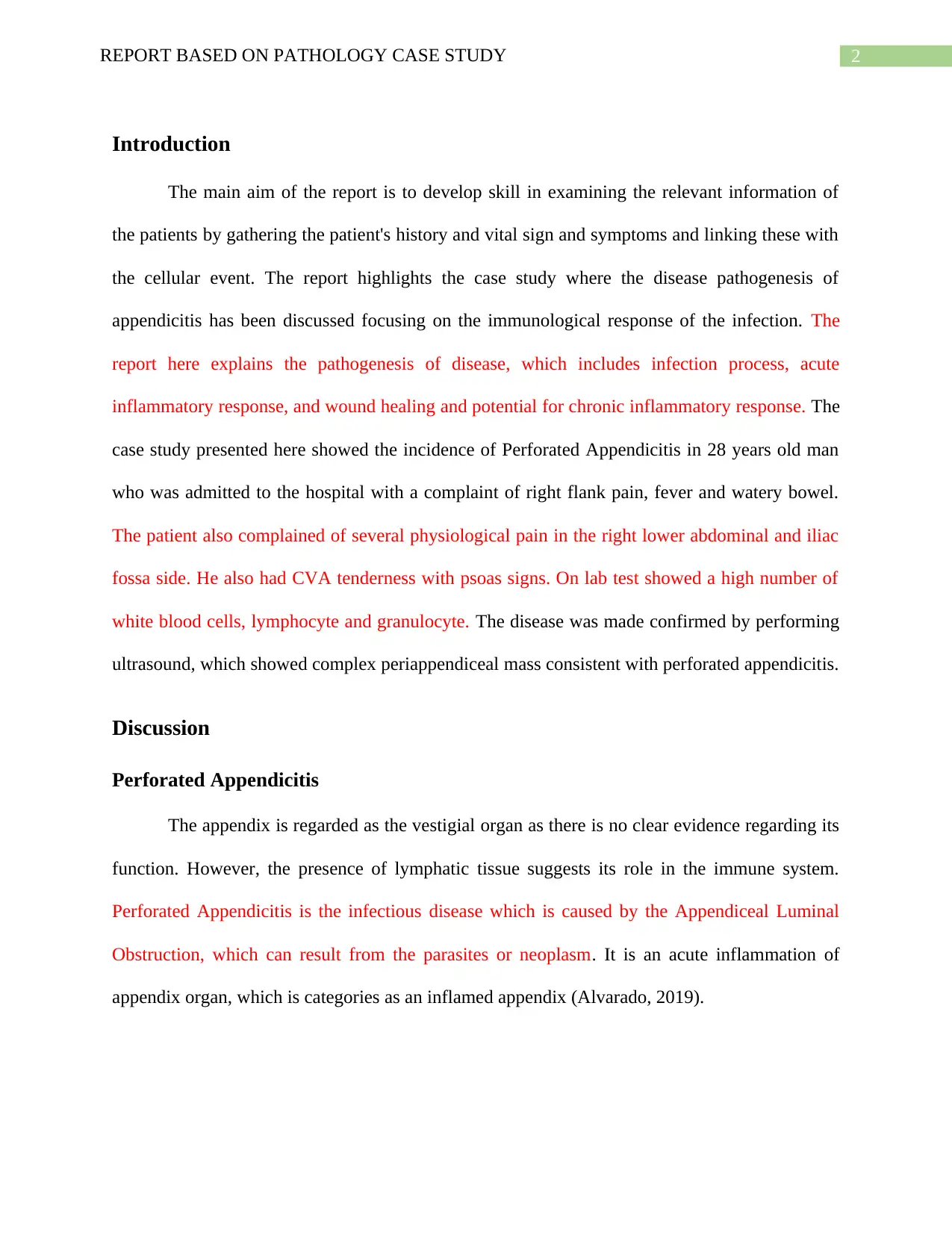
2REPORT BASED ON PATHOLOGY CASE STUDY
Introduction
The main aim of the report is to develop skill in examining the relevant information of
the patients by gathering the patient's history and vital sign and symptoms and linking these with
the cellular event. The report highlights the case study where the disease pathogenesis of
appendicitis has been discussed focusing on the immunological response of the infection. The
report here explains the pathogenesis of disease, which includes infection process, acute
inflammatory response, and wound healing and potential for chronic inflammatory response. The
case study presented here showed the incidence of Perforated Appendicitis in 28 years old man
who was admitted to the hospital with a complaint of right flank pain, fever and watery bowel.
The patient also complained of several physiological pain in the right lower abdominal and iliac
fossa side. He also had CVA tenderness with psoas signs. On lab test showed a high number of
white blood cells, lymphocyte and granulocyte. The disease was made confirmed by performing
ultrasound, which showed complex periappendiceal mass consistent with perforated appendicitis.
Discussion
Perforated Appendicitis
The appendix is regarded as the vestigial organ as there is no clear evidence regarding its
function. However, the presence of lymphatic tissue suggests its role in the immune system.
Perforated Appendicitis is the infectious disease which is caused by the Appendiceal Luminal
Obstruction, which can result from the parasites or neoplasm. It is an acute inflammation of
appendix organ, which is categories as an inflamed appendix (Alvarado, 2019).
Introduction
The main aim of the report is to develop skill in examining the relevant information of
the patients by gathering the patient's history and vital sign and symptoms and linking these with
the cellular event. The report highlights the case study where the disease pathogenesis of
appendicitis has been discussed focusing on the immunological response of the infection. The
report here explains the pathogenesis of disease, which includes infection process, acute
inflammatory response, and wound healing and potential for chronic inflammatory response. The
case study presented here showed the incidence of Perforated Appendicitis in 28 years old man
who was admitted to the hospital with a complaint of right flank pain, fever and watery bowel.
The patient also complained of several physiological pain in the right lower abdominal and iliac
fossa side. He also had CVA tenderness with psoas signs. On lab test showed a high number of
white blood cells, lymphocyte and granulocyte. The disease was made confirmed by performing
ultrasound, which showed complex periappendiceal mass consistent with perforated appendicitis.
Discussion
Perforated Appendicitis
The appendix is regarded as the vestigial organ as there is no clear evidence regarding its
function. However, the presence of lymphatic tissue suggests its role in the immune system.
Perforated Appendicitis is the infectious disease which is caused by the Appendiceal Luminal
Obstruction, which can result from the parasites or neoplasm. It is an acute inflammation of
appendix organ, which is categories as an inflamed appendix (Alvarado, 2019).
⊘ This is a preview!⊘
Do you want full access?
Subscribe today to unlock all pages.

Trusted by 1+ million students worldwide
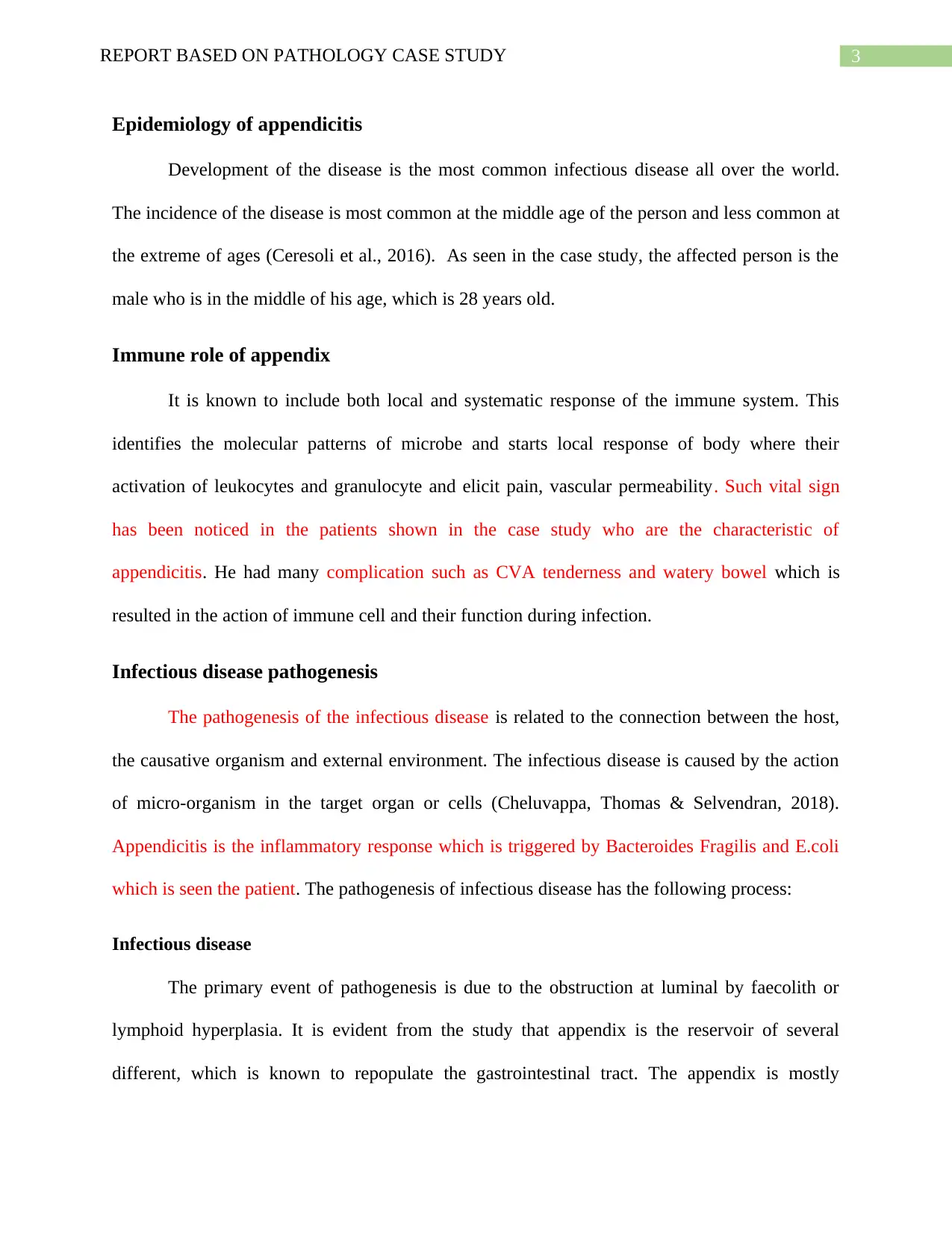
3REPORT BASED ON PATHOLOGY CASE STUDY
Epidemiology of appendicitis
Development of the disease is the most common infectious disease all over the world.
The incidence of the disease is most common at the middle age of the person and less common at
the extreme of ages (Ceresoli et al., 2016). As seen in the case study, the affected person is the
male who is in the middle of his age, which is 28 years old.
Immune role of appendix
It is known to include both local and systematic response of the immune system. This
identifies the molecular patterns of microbe and starts local response of body where their
activation of leukocytes and granulocyte and elicit pain, vascular permeability. Such vital sign
has been noticed in the patients shown in the case study who are the characteristic of
appendicitis. He had many complication such as CVA tenderness and watery bowel which is
resulted in the action of immune cell and their function during infection.
Infectious disease pathogenesis
The pathogenesis of the infectious disease is related to the connection between the host,
the causative organism and external environment. The infectious disease is caused by the action
of micro-organism in the target organ or cells (Cheluvappa, Thomas & Selvendran, 2018).
Appendicitis is the inflammatory response which is triggered by Bacteroides Fragilis and E.coli
which is seen the patient. The pathogenesis of infectious disease has the following process:
Infectious disease
The primary event of pathogenesis is due to the obstruction at luminal by faecolith or
lymphoid hyperplasia. It is evident from the study that appendix is the reservoir of several
different, which is known to repopulate the gastrointestinal tract. The appendix is mostly
Epidemiology of appendicitis
Development of the disease is the most common infectious disease all over the world.
The incidence of the disease is most common at the middle age of the person and less common at
the extreme of ages (Ceresoli et al., 2016). As seen in the case study, the affected person is the
male who is in the middle of his age, which is 28 years old.
Immune role of appendix
It is known to include both local and systematic response of the immune system. This
identifies the molecular patterns of microbe and starts local response of body where their
activation of leukocytes and granulocyte and elicit pain, vascular permeability. Such vital sign
has been noticed in the patients shown in the case study who are the characteristic of
appendicitis. He had many complication such as CVA tenderness and watery bowel which is
resulted in the action of immune cell and their function during infection.
Infectious disease pathogenesis
The pathogenesis of the infectious disease is related to the connection between the host,
the causative organism and external environment. The infectious disease is caused by the action
of micro-organism in the target organ or cells (Cheluvappa, Thomas & Selvendran, 2018).
Appendicitis is the inflammatory response which is triggered by Bacteroides Fragilis and E.coli
which is seen the patient. The pathogenesis of infectious disease has the following process:
Infectious disease
The primary event of pathogenesis is due to the obstruction at luminal by faecolith or
lymphoid hyperplasia. It is evident from the study that appendix is the reservoir of several
different, which is known to repopulate the gastrointestinal tract. The appendix is mostly
Paraphrase This Document
Need a fresh take? Get an instant paraphrase of this document with our AI Paraphraser
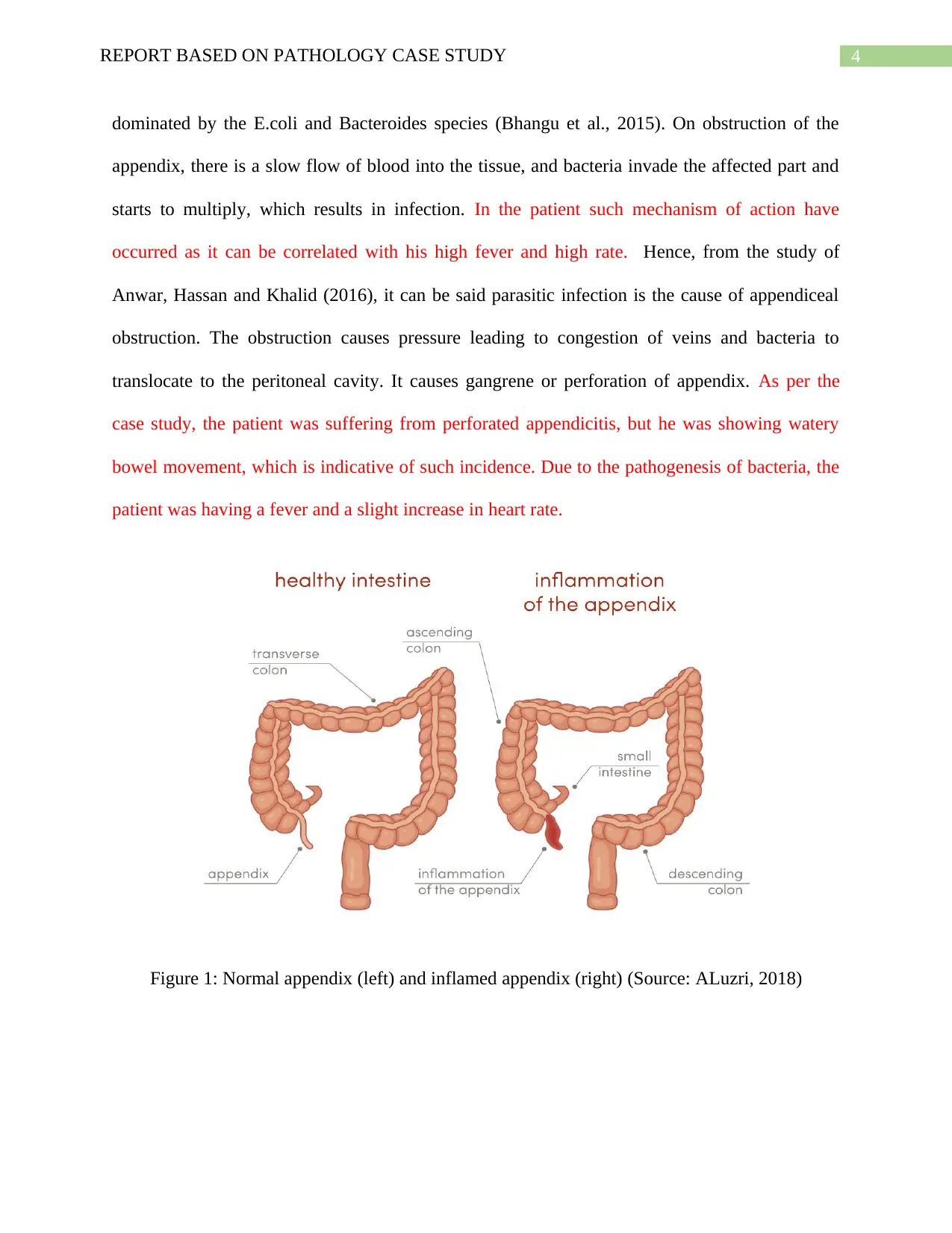
4REPORT BASED ON PATHOLOGY CASE STUDY
dominated by the E.coli and Bacteroides species (Bhangu et al., 2015). On obstruction of the
appendix, there is a slow flow of blood into the tissue, and bacteria invade the affected part and
starts to multiply, which results in infection. In the patient such mechanism of action have
occurred as it can be correlated with his high fever and high rate. Hence, from the study of
Anwar, Hassan and Khalid (2016), it can be said parasitic infection is the cause of appendiceal
obstruction. The obstruction causes pressure leading to congestion of veins and bacteria to
translocate to the peritoneal cavity. It causes gangrene or perforation of appendix. As per the
case study, the patient was suffering from perforated appendicitis, but he was showing watery
bowel movement, which is indicative of such incidence. Due to the pathogenesis of bacteria, the
patient was having a fever and a slight increase in heart rate.
Figure 1: Normal appendix (left) and inflamed appendix (right) (Source: ALuzri, 2018)
dominated by the E.coli and Bacteroides species (Bhangu et al., 2015). On obstruction of the
appendix, there is a slow flow of blood into the tissue, and bacteria invade the affected part and
starts to multiply, which results in infection. In the patient such mechanism of action have
occurred as it can be correlated with his high fever and high rate. Hence, from the study of
Anwar, Hassan and Khalid (2016), it can be said parasitic infection is the cause of appendiceal
obstruction. The obstruction causes pressure leading to congestion of veins and bacteria to
translocate to the peritoneal cavity. It causes gangrene or perforation of appendix. As per the
case study, the patient was suffering from perforated appendicitis, but he was showing watery
bowel movement, which is indicative of such incidence. Due to the pathogenesis of bacteria, the
patient was having a fever and a slight increase in heart rate.
Figure 1: Normal appendix (left) and inflamed appendix (right) (Source: ALuzri, 2018)
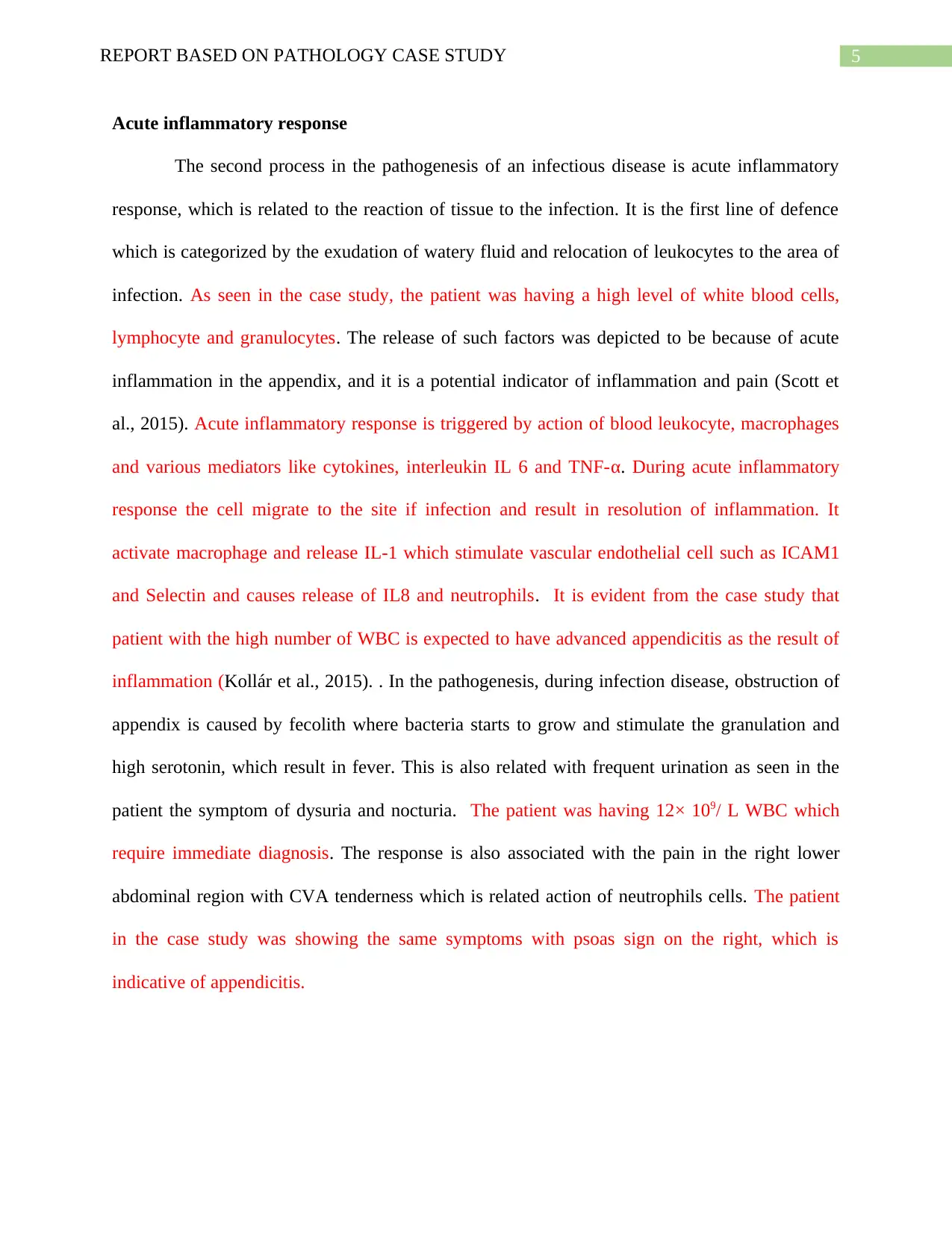
5REPORT BASED ON PATHOLOGY CASE STUDY
Acute inflammatory response
The second process in the pathogenesis of an infectious disease is acute inflammatory
response, which is related to the reaction of tissue to the infection. It is the first line of defence
which is categorized by the exudation of watery fluid and relocation of leukocytes to the area of
infection. As seen in the case study, the patient was having a high level of white blood cells,
lymphocyte and granulocytes. The release of such factors was depicted to be because of acute
inflammation in the appendix, and it is a potential indicator of inflammation and pain (Scott et
al., 2015). Acute inflammatory response is triggered by action of blood leukocyte, macrophages
and various mediators like cytokines, interleukin IL 6 and TNF-α. During acute inflammatory
response the cell migrate to the site if infection and result in resolution of inflammation. It
activate macrophage and release IL-1 which stimulate vascular endothelial cell such as ICAM1
and Selectin and causes release of IL8 and neutrophils. It is evident from the case study that
patient with the high number of WBC is expected to have advanced appendicitis as the result of
inflammation (Kollár et al., 2015). . In the pathogenesis, during infection disease, obstruction of
appendix is caused by fecolith where bacteria starts to grow and stimulate the granulation and
high serotonin, which result in fever. This is also related with frequent urination as seen in the
patient the symptom of dysuria and nocturia. The patient was having 12× 109/ L WBC which
require immediate diagnosis. The response is also associated with the pain in the right lower
abdominal region with CVA tenderness which is related action of neutrophils cells. The patient
in the case study was showing the same symptoms with psoas sign on the right, which is
indicative of appendicitis.
Acute inflammatory response
The second process in the pathogenesis of an infectious disease is acute inflammatory
response, which is related to the reaction of tissue to the infection. It is the first line of defence
which is categorized by the exudation of watery fluid and relocation of leukocytes to the area of
infection. As seen in the case study, the patient was having a high level of white blood cells,
lymphocyte and granulocytes. The release of such factors was depicted to be because of acute
inflammation in the appendix, and it is a potential indicator of inflammation and pain (Scott et
al., 2015). Acute inflammatory response is triggered by action of blood leukocyte, macrophages
and various mediators like cytokines, interleukin IL 6 and TNF-α. During acute inflammatory
response the cell migrate to the site if infection and result in resolution of inflammation. It
activate macrophage and release IL-1 which stimulate vascular endothelial cell such as ICAM1
and Selectin and causes release of IL8 and neutrophils. It is evident from the case study that
patient with the high number of WBC is expected to have advanced appendicitis as the result of
inflammation (Kollár et al., 2015). . In the pathogenesis, during infection disease, obstruction of
appendix is caused by fecolith where bacteria starts to grow and stimulate the granulation and
high serotonin, which result in fever. This is also related with frequent urination as seen in the
patient the symptom of dysuria and nocturia. The patient was having 12× 109/ L WBC which
require immediate diagnosis. The response is also associated with the pain in the right lower
abdominal region with CVA tenderness which is related action of neutrophils cells. The patient
in the case study was showing the same symptoms with psoas sign on the right, which is
indicative of appendicitis.
⊘ This is a preview!⊘
Do you want full access?
Subscribe today to unlock all pages.

Trusted by 1+ million students worldwide
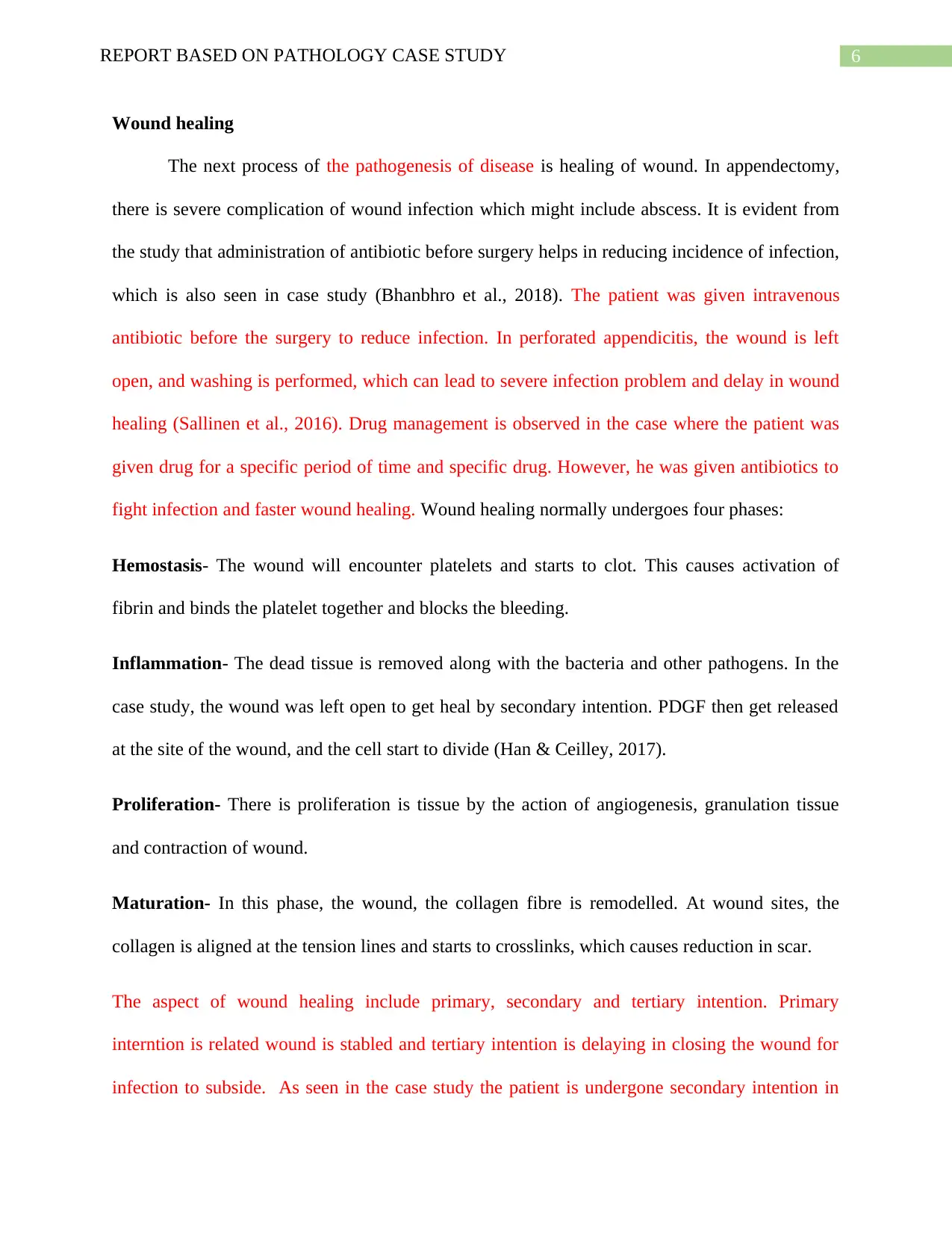
6REPORT BASED ON PATHOLOGY CASE STUDY
Wound healing
The next process of the pathogenesis of disease is healing of wound. In appendectomy,
there is severe complication of wound infection which might include abscess. It is evident from
the study that administration of antibiotic before surgery helps in reducing incidence of infection,
which is also seen in case study (Bhanbhro et al., 2018). The patient was given intravenous
antibiotic before the surgery to reduce infection. In perforated appendicitis, the wound is left
open, and washing is performed, which can lead to severe infection problem and delay in wound
healing (Sallinen et al., 2016). Drug management is observed in the case where the patient was
given drug for a specific period of time and specific drug. However, he was given antibiotics to
fight infection and faster wound healing. Wound healing normally undergoes four phases:
Hemostasis- The wound will encounter platelets and starts to clot. This causes activation of
fibrin and binds the platelet together and blocks the bleeding.
Inflammation- The dead tissue is removed along with the bacteria and other pathogens. In the
case study, the wound was left open to get heal by secondary intention. PDGF then get released
at the site of the wound, and the cell start to divide (Han & Ceilley, 2017).
Proliferation- There is proliferation is tissue by the action of angiogenesis, granulation tissue
and contraction of wound.
Maturation- In this phase, the wound, the collagen fibre is remodelled. At wound sites, the
collagen is aligned at the tension lines and starts to crosslinks, which causes reduction in scar.
The aspect of wound healing include primary, secondary and tertiary intention. Primary
interntion is related wound is stabled and tertiary intention is delaying in closing the wound for
infection to subside. As seen in the case study the patient is undergone secondary intention in
Wound healing
The next process of the pathogenesis of disease is healing of wound. In appendectomy,
there is severe complication of wound infection which might include abscess. It is evident from
the study that administration of antibiotic before surgery helps in reducing incidence of infection,
which is also seen in case study (Bhanbhro et al., 2018). The patient was given intravenous
antibiotic before the surgery to reduce infection. In perforated appendicitis, the wound is left
open, and washing is performed, which can lead to severe infection problem and delay in wound
healing (Sallinen et al., 2016). Drug management is observed in the case where the patient was
given drug for a specific period of time and specific drug. However, he was given antibiotics to
fight infection and faster wound healing. Wound healing normally undergoes four phases:
Hemostasis- The wound will encounter platelets and starts to clot. This causes activation of
fibrin and binds the platelet together and blocks the bleeding.
Inflammation- The dead tissue is removed along with the bacteria and other pathogens. In the
case study, the wound was left open to get heal by secondary intention. PDGF then get released
at the site of the wound, and the cell start to divide (Han & Ceilley, 2017).
Proliferation- There is proliferation is tissue by the action of angiogenesis, granulation tissue
and contraction of wound.
Maturation- In this phase, the wound, the collagen fibre is remodelled. At wound sites, the
collagen is aligned at the tension lines and starts to crosslinks, which causes reduction in scar.
The aspect of wound healing include primary, secondary and tertiary intention. Primary
interntion is related wound is stabled and tertiary intention is delaying in closing the wound for
infection to subside. As seen in the case study the patient is undergone secondary intention in
Paraphrase This Document
Need a fresh take? Get an instant paraphrase of this document with our AI Paraphraser
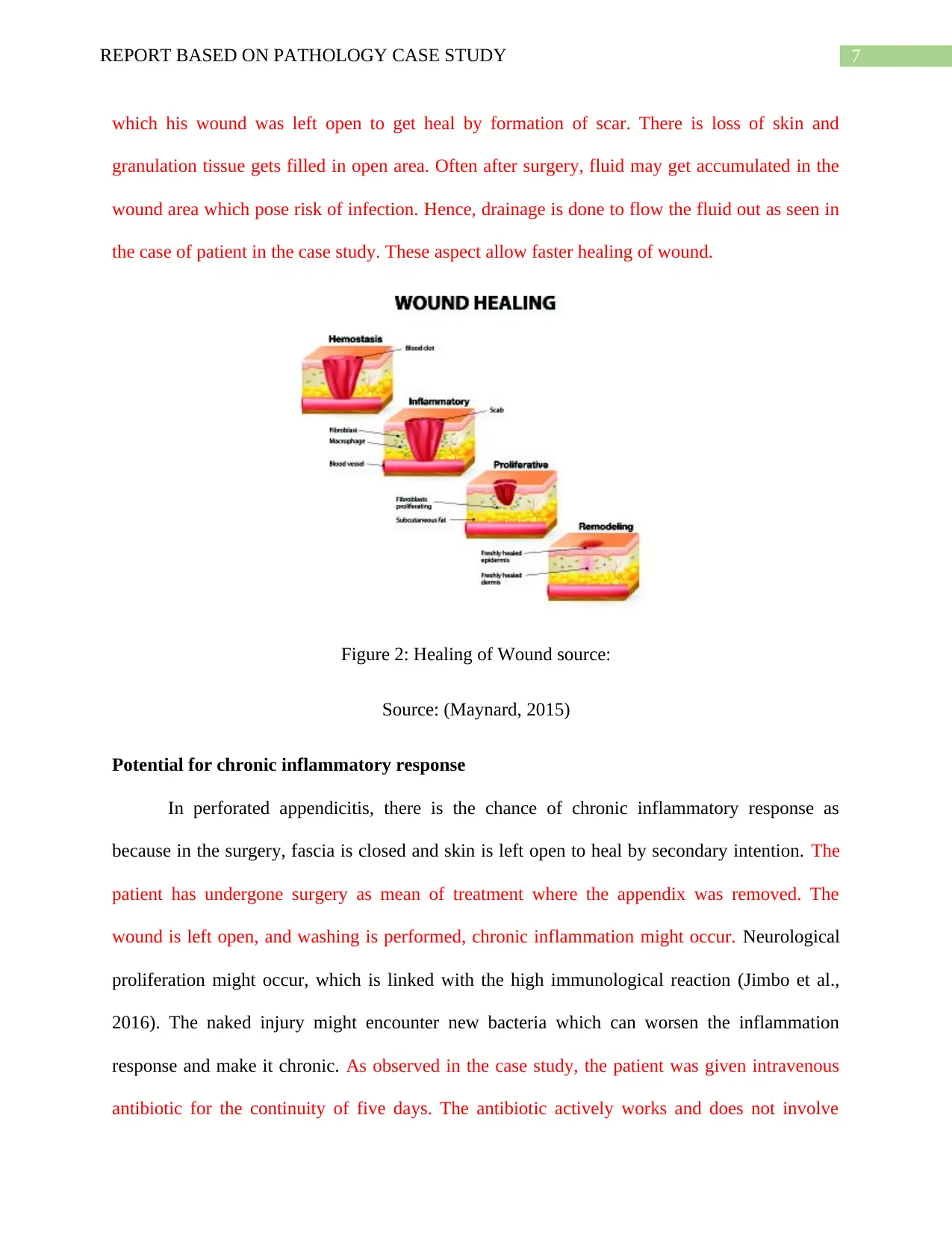
7REPORT BASED ON PATHOLOGY CASE STUDY
which his wound was left open to get heal by formation of scar. There is loss of skin and
granulation tissue gets filled in open area. Often after surgery, fluid may get accumulated in the
wound area which pose risk of infection. Hence, drainage is done to flow the fluid out as seen in
the case of patient in the case study. These aspect allow faster healing of wound.
Figure 2: Healing of Wound source:
Source: (Maynard, 2015)
Potential for chronic inflammatory response
In perforated appendicitis, there is the chance of chronic inflammatory response as
because in the surgery, fascia is closed and skin is left open to heal by secondary intention. The
patient has undergone surgery as mean of treatment where the appendix was removed. The
wound is left open, and washing is performed, chronic inflammation might occur. Neurological
proliferation might occur, which is linked with the high immunological reaction (Jimbo et al.,
2016). The naked injury might encounter new bacteria which can worsen the inflammation
response and make it chronic. As observed in the case study, the patient was given intravenous
antibiotic for the continuity of five days. The antibiotic actively works and does not involve
which his wound was left open to get heal by formation of scar. There is loss of skin and
granulation tissue gets filled in open area. Often after surgery, fluid may get accumulated in the
wound area which pose risk of infection. Hence, drainage is done to flow the fluid out as seen in
the case of patient in the case study. These aspect allow faster healing of wound.
Figure 2: Healing of Wound source:
Source: (Maynard, 2015)
Potential for chronic inflammatory response
In perforated appendicitis, there is the chance of chronic inflammatory response as
because in the surgery, fascia is closed and skin is left open to heal by secondary intention. The
patient has undergone surgery as mean of treatment where the appendix was removed. The
wound is left open, and washing is performed, chronic inflammation might occur. Neurological
proliferation might occur, which is linked with the high immunological reaction (Jimbo et al.,
2016). The naked injury might encounter new bacteria which can worsen the inflammation
response and make it chronic. As observed in the case study, the patient was given intravenous
antibiotic for the continuity of five days. The antibiotic actively works and does not involve
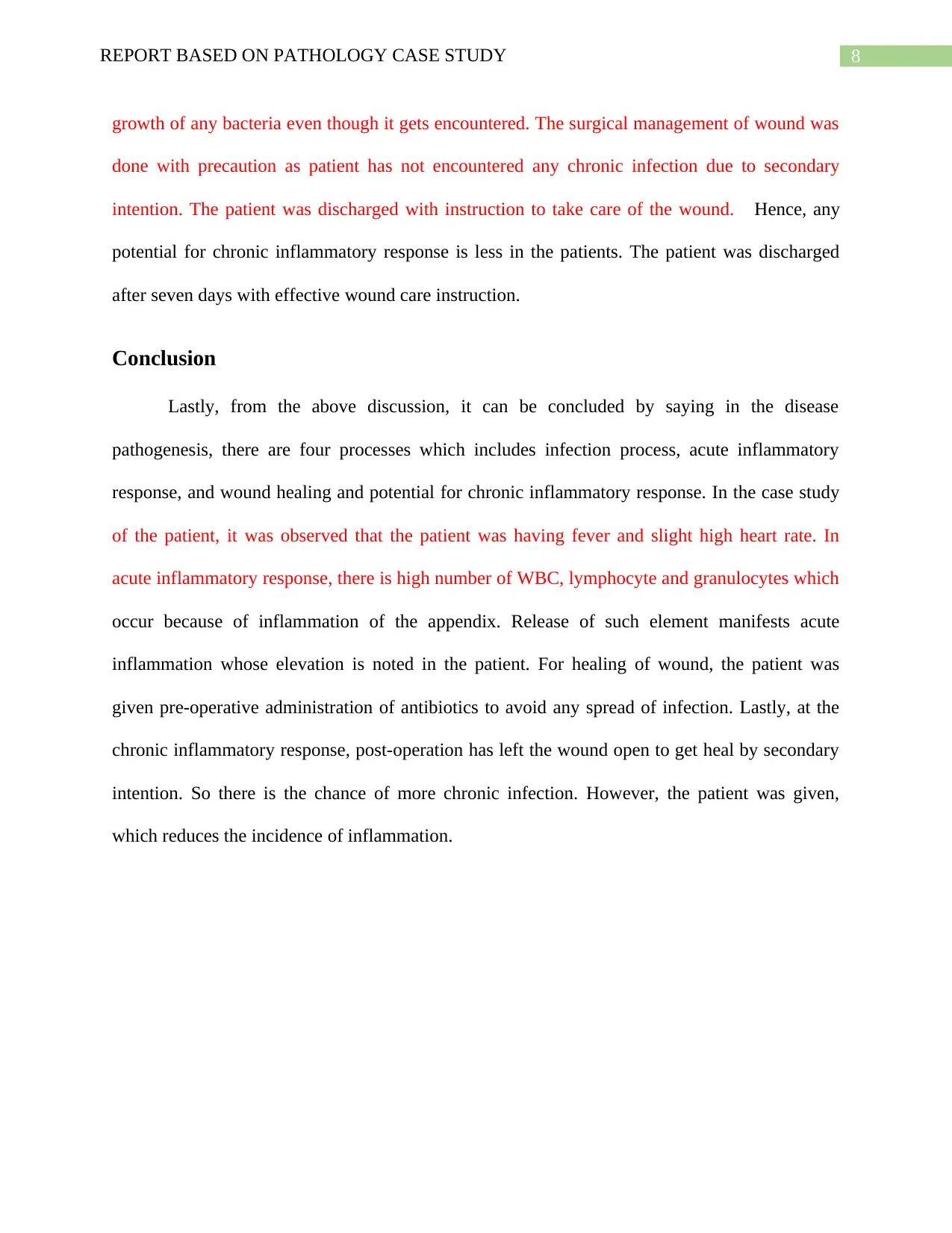
8REPORT BASED ON PATHOLOGY CASE STUDY
growth of any bacteria even though it gets encountered. The surgical management of wound was
done with precaution as patient has not encountered any chronic infection due to secondary
intention. The patient was discharged with instruction to take care of the wound. Hence, any
potential for chronic inflammatory response is less in the patients. The patient was discharged
after seven days with effective wound care instruction.
Conclusion
Lastly, from the above discussion, it can be concluded by saying in the disease
pathogenesis, there are four processes which includes infection process, acute inflammatory
response, and wound healing and potential for chronic inflammatory response. In the case study
of the patient, it was observed that the patient was having fever and slight high heart rate. In
acute inflammatory response, there is high number of WBC, lymphocyte and granulocytes which
occur because of inflammation of the appendix. Release of such element manifests acute
inflammation whose elevation is noted in the patient. For healing of wound, the patient was
given pre-operative administration of antibiotics to avoid any spread of infection. Lastly, at the
chronic inflammatory response, post-operation has left the wound open to get heal by secondary
intention. So there is the chance of more chronic infection. However, the patient was given,
which reduces the incidence of inflammation.
growth of any bacteria even though it gets encountered. The surgical management of wound was
done with precaution as patient has not encountered any chronic infection due to secondary
intention. The patient was discharged with instruction to take care of the wound. Hence, any
potential for chronic inflammatory response is less in the patients. The patient was discharged
after seven days with effective wound care instruction.
Conclusion
Lastly, from the above discussion, it can be concluded by saying in the disease
pathogenesis, there are four processes which includes infection process, acute inflammatory
response, and wound healing and potential for chronic inflammatory response. In the case study
of the patient, it was observed that the patient was having fever and slight high heart rate. In
acute inflammatory response, there is high number of WBC, lymphocyte and granulocytes which
occur because of inflammation of the appendix. Release of such element manifests acute
inflammation whose elevation is noted in the patient. For healing of wound, the patient was
given pre-operative administration of antibiotics to avoid any spread of infection. Lastly, at the
chronic inflammatory response, post-operation has left the wound open to get heal by secondary
intention. So there is the chance of more chronic infection. However, the patient was given,
which reduces the incidence of inflammation.
⊘ This is a preview!⊘
Do you want full access?
Subscribe today to unlock all pages.

Trusted by 1+ million students worldwide
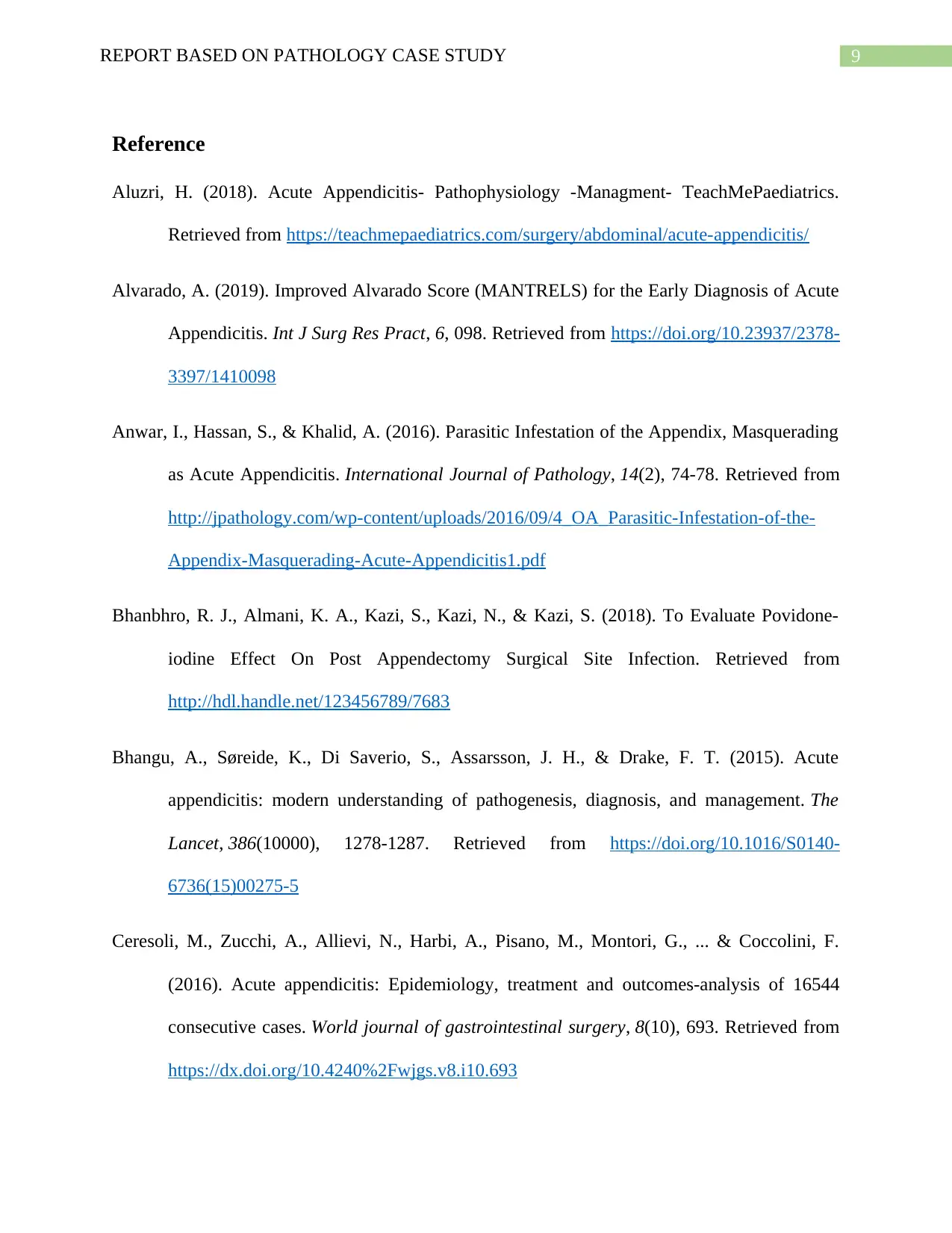
9REPORT BASED ON PATHOLOGY CASE STUDY
Reference
Aluzri, H. (2018). Acute Appendicitis- Pathophysiology -Managment- TeachMePaediatrics.
Retrieved from https://teachmepaediatrics.com/surgery/abdominal/acute-appendicitis/
Alvarado, A. (2019). Improved Alvarado Score (MANTRELS) for the Early Diagnosis of Acute
Appendicitis. Int J Surg Res Pract, 6, 098. Retrieved from https://doi.org/10.23937/2378-
3397/1410098
Anwar, I., Hassan, S., & Khalid, A. (2016). Parasitic Infestation of the Appendix, Masquerading
as Acute Appendicitis. International Journal of Pathology, 14(2), 74-78. Retrieved from
http://jpathology.com/wp-content/uploads/2016/09/4_OA_Parasitic-Infestation-of-the-
Appendix-Masquerading-Acute-Appendicitis1.pdf
Bhanbhro, R. J., Almani, K. A., Kazi, S., Kazi, N., & Kazi, S. (2018). To Evaluate Povidone-
iodine Effect On Post Appendectomy Surgical Site Infection. Retrieved from
http://hdl.handle.net/123456789/7683
Bhangu, A., Søreide, K., Di Saverio, S., Assarsson, J. H., & Drake, F. T. (2015). Acute
appendicitis: modern understanding of pathogenesis, diagnosis, and management. The
Lancet, 386(10000), 1278-1287. Retrieved from https://doi.org/10.1016/S0140-
6736(15)00275-5
Ceresoli, M., Zucchi, A., Allievi, N., Harbi, A., Pisano, M., Montori, G., ... & Coccolini, F.
(2016). Acute appendicitis: Epidemiology, treatment and outcomes-analysis of 16544
consecutive cases. World journal of gastrointestinal surgery, 8(10), 693. Retrieved from
https://dx.doi.org/10.4240%2Fwjgs.v8.i10.693
Reference
Aluzri, H. (2018). Acute Appendicitis- Pathophysiology -Managment- TeachMePaediatrics.
Retrieved from https://teachmepaediatrics.com/surgery/abdominal/acute-appendicitis/
Alvarado, A. (2019). Improved Alvarado Score (MANTRELS) for the Early Diagnosis of Acute
Appendicitis. Int J Surg Res Pract, 6, 098. Retrieved from https://doi.org/10.23937/2378-
3397/1410098
Anwar, I., Hassan, S., & Khalid, A. (2016). Parasitic Infestation of the Appendix, Masquerading
as Acute Appendicitis. International Journal of Pathology, 14(2), 74-78. Retrieved from
http://jpathology.com/wp-content/uploads/2016/09/4_OA_Parasitic-Infestation-of-the-
Appendix-Masquerading-Acute-Appendicitis1.pdf
Bhanbhro, R. J., Almani, K. A., Kazi, S., Kazi, N., & Kazi, S. (2018). To Evaluate Povidone-
iodine Effect On Post Appendectomy Surgical Site Infection. Retrieved from
http://hdl.handle.net/123456789/7683
Bhangu, A., Søreide, K., Di Saverio, S., Assarsson, J. H., & Drake, F. T. (2015). Acute
appendicitis: modern understanding of pathogenesis, diagnosis, and management. The
Lancet, 386(10000), 1278-1287. Retrieved from https://doi.org/10.1016/S0140-
6736(15)00275-5
Ceresoli, M., Zucchi, A., Allievi, N., Harbi, A., Pisano, M., Montori, G., ... & Coccolini, F.
(2016). Acute appendicitis: Epidemiology, treatment and outcomes-analysis of 16544
consecutive cases. World journal of gastrointestinal surgery, 8(10), 693. Retrieved from
https://dx.doi.org/10.4240%2Fwjgs.v8.i10.693
Paraphrase This Document
Need a fresh take? Get an instant paraphrase of this document with our AI Paraphraser
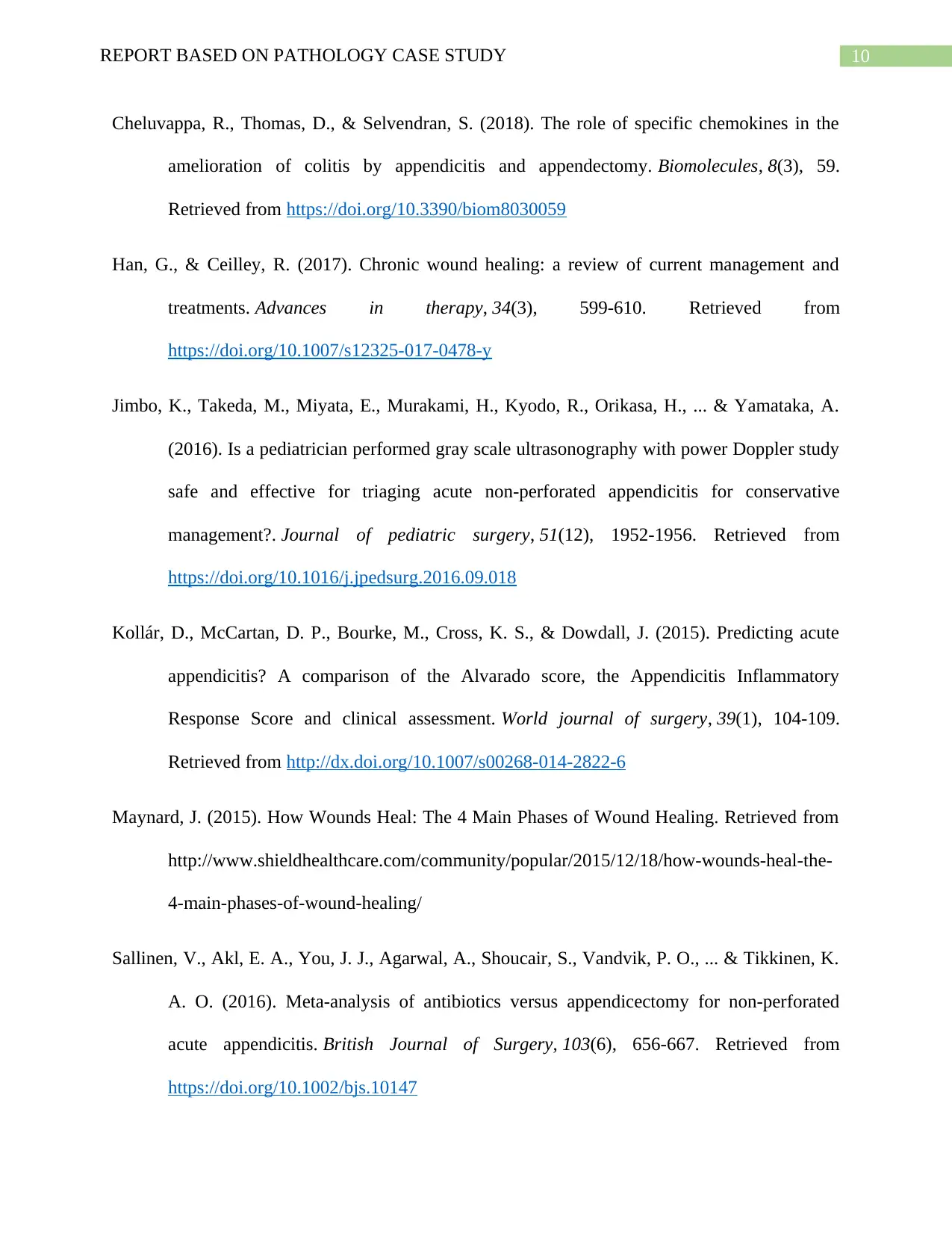
10REPORT BASED ON PATHOLOGY CASE STUDY
Cheluvappa, R., Thomas, D., & Selvendran, S. (2018). The role of specific chemokines in the
amelioration of colitis by appendicitis and appendectomy. Biomolecules, 8(3), 59.
Retrieved from https://doi.org/10.3390/biom8030059
Han, G., & Ceilley, R. (2017). Chronic wound healing: a review of current management and
treatments. Advances in therapy, 34(3), 599-610. Retrieved from
https://doi.org/10.1007/s12325-017-0478-y
Jimbo, K., Takeda, M., Miyata, E., Murakami, H., Kyodo, R., Orikasa, H., ... & Yamataka, A.
(2016). Is a pediatrician performed gray scale ultrasonography with power Doppler study
safe and effective for triaging acute non-perforated appendicitis for conservative
management?. Journal of pediatric surgery, 51(12), 1952-1956. Retrieved from
https://doi.org/10.1016/j.jpedsurg.2016.09.018
Kollár, D., McCartan, D. P., Bourke, M., Cross, K. S., & Dowdall, J. (2015). Predicting acute
appendicitis? A comparison of the Alvarado score, the Appendicitis Inflammatory
Response Score and clinical assessment. World journal of surgery, 39(1), 104-109.
Retrieved from http://dx.doi.org/10.1007/s00268-014-2822-6
Maynard, J. (2015). How Wounds Heal: The 4 Main Phases of Wound Healing. Retrieved from
http://www.shieldhealthcare.com/community/popular/2015/12/18/how-wounds-heal-the-
4-main-phases-of-wound-healing/
Sallinen, V., Akl, E. A., You, J. J., Agarwal, A., Shoucair, S., Vandvik, P. O., ... & Tikkinen, K.
A. O. (2016). Meta‐analysis of antibiotics versus appendicectomy for non‐perforated
acute appendicitis. British Journal of Surgery, 103(6), 656-667. Retrieved from
https://doi.org/10.1002/bjs.10147
Cheluvappa, R., Thomas, D., & Selvendran, S. (2018). The role of specific chemokines in the
amelioration of colitis by appendicitis and appendectomy. Biomolecules, 8(3), 59.
Retrieved from https://doi.org/10.3390/biom8030059
Han, G., & Ceilley, R. (2017). Chronic wound healing: a review of current management and
treatments. Advances in therapy, 34(3), 599-610. Retrieved from
https://doi.org/10.1007/s12325-017-0478-y
Jimbo, K., Takeda, M., Miyata, E., Murakami, H., Kyodo, R., Orikasa, H., ... & Yamataka, A.
(2016). Is a pediatrician performed gray scale ultrasonography with power Doppler study
safe and effective for triaging acute non-perforated appendicitis for conservative
management?. Journal of pediatric surgery, 51(12), 1952-1956. Retrieved from
https://doi.org/10.1016/j.jpedsurg.2016.09.018
Kollár, D., McCartan, D. P., Bourke, M., Cross, K. S., & Dowdall, J. (2015). Predicting acute
appendicitis? A comparison of the Alvarado score, the Appendicitis Inflammatory
Response Score and clinical assessment. World journal of surgery, 39(1), 104-109.
Retrieved from http://dx.doi.org/10.1007/s00268-014-2822-6
Maynard, J. (2015). How Wounds Heal: The 4 Main Phases of Wound Healing. Retrieved from
http://www.shieldhealthcare.com/community/popular/2015/12/18/how-wounds-heal-the-
4-main-phases-of-wound-healing/
Sallinen, V., Akl, E. A., You, J. J., Agarwal, A., Shoucair, S., Vandvik, P. O., ... & Tikkinen, K.
A. O. (2016). Meta‐analysis of antibiotics versus appendicectomy for non‐perforated
acute appendicitis. British Journal of Surgery, 103(6), 656-667. Retrieved from
https://doi.org/10.1002/bjs.10147
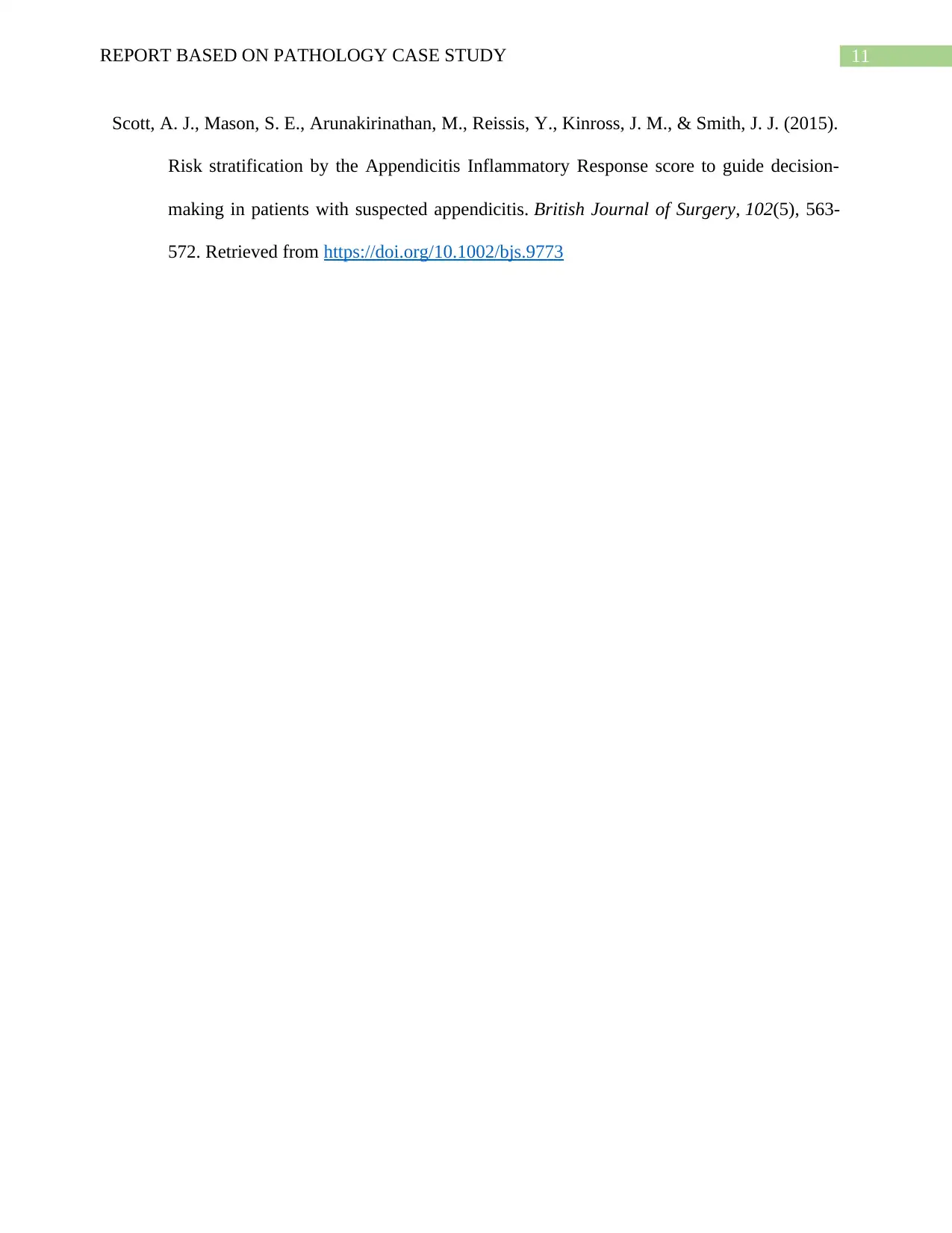
11REPORT BASED ON PATHOLOGY CASE STUDY
Scott, A. J., Mason, S. E., Arunakirinathan, M., Reissis, Y., Kinross, J. M., & Smith, J. J. (2015).
Risk stratification by the Appendicitis Inflammatory Response score to guide decision‐
making in patients with suspected appendicitis. British Journal of Surgery, 102(5), 563-
572. Retrieved from https://doi.org/10.1002/bjs.9773
Scott, A. J., Mason, S. E., Arunakirinathan, M., Reissis, Y., Kinross, J. M., & Smith, J. J. (2015).
Risk stratification by the Appendicitis Inflammatory Response score to guide decision‐
making in patients with suspected appendicitis. British Journal of Surgery, 102(5), 563-
572. Retrieved from https://doi.org/10.1002/bjs.9773
⊘ This is a preview!⊘
Do you want full access?
Subscribe today to unlock all pages.

Trusted by 1+ million students worldwide
1 out of 12
Related Documents
Your All-in-One AI-Powered Toolkit for Academic Success.
+13062052269
info@desklib.com
Available 24*7 on WhatsApp / Email
![[object Object]](/_next/static/media/star-bottom.7253800d.svg)
Unlock your academic potential
Copyright © 2020–2025 A2Z Services. All Rights Reserved. Developed and managed by ZUCOL.





